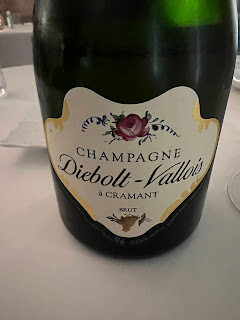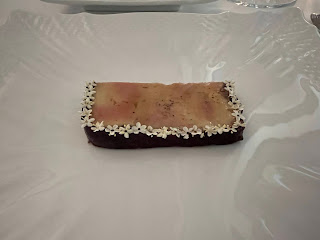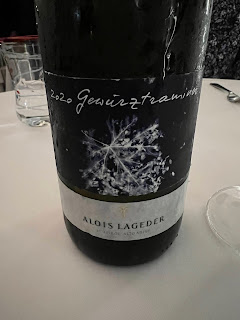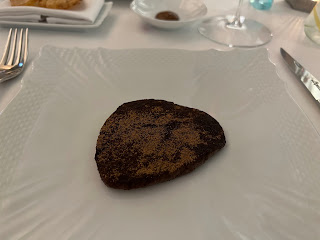This Italian restaurant is located on 8th floor of One Chinachem Central, right in the heart of the busy financial district on Hong Kong Island. Opened in 2017, it has been awarded Michelin one-star status, with resident chef Roland Schuller leading the team.
Arriving sharp at 6:30pm and after the registration, the chef opened the secret door leading to the spacious dining area. We were seated on the window side, and immediately I came to like the décor, which showed minimalist elegance, offering a comfortable and contemporary environment.
We decided to go for the 8-course Degustation Menu ($1,888 each) and wine pairing ($880). The staff then served us a starter with Black Olives and Anchovies. The olives were good, and the quality of the anchovies was amazing, with intense savoury note but not overly salty.
The first Amuse Bouche was a Salmon Tartare with Chives. The minced salmon was seasoned beautifully, with the fish oil seeping great flavours. The chives added the fragrance and serving on a crunchy crust, this was a great beginning of a wonderful meal.
The second Amuse Bouche was visually appealing. The Parmesan Potato Ball had been added with a slice of Anchovy, and topped with a small piece of Comte, beautifully presented on a plate of seashells and green crumbs. The rich cheesy taste perfect match with the savoury flavours from the anchovy, and created further eager anticipation for our first course.
Coming to the first course, Tuna Belly with Mustard, Ikura and Beluga Caviar. The tuna belly was thinly sliced, and then mixed with tomato water to give a bit of sourness, freshening the palate. The mix of salmon roes and caviar not only provided a contrast in colour, also with different umami and texture, creating a highly complex dish of great appeal. The edible flowers on top further added to the visual delights. The wine paired was Diebolt-Vallois Prestige Blanc de Blancs Brut NV, a Champagne made from entirely Chardonnay grapes.
The second course was Goose Foie Gras with Figs and Brioche. The foie gras was slow cooked and then cut into a slide, surrounded with a fig paste decorated with small white flowers. Rich in flavours, creamy in texture, but without the heavy and oily mouthfeel of the seared version. The chef also provided a brioche toast for us to eat with the foie gras, a thoughtful gesture. The wine paired was 2020 Alois Lageder Gewurztraminer from Alto Adige.
The third course was Abalone with Black and White Truffle. The abalone was braised to perfection, tender with a nice bite, and the black truffle sauce was intense on flavours, a good complement with the umami taste of the abalone. With some white and black truffle shaved on top, it was a great combination of Japanese and Italian ingredients to the best effect. The wine paired was 2019 Planeta Chardonnay from Menfi Sicily.
In the current white truffle season, there was no reason we did not order an additional dish of this great delicacy. The White Truffle Tagliolini ($1,180) was recommended by the staff, and he also helped to split the portion into two. Chef Roland himself came to bring three pieces of white truffles and shaved a generous amount for each of us. The aromas were already noticeable from a distance, and together with the impeccably good egg pasta, offered a great culinary treat. The simple light sauce was perfectly in harmony with the white truffle notes, and for this dish alone I would like to return the restaurant again. I also ordered a glass of 2017 of Anrar Riserva from Kellerei Cantina Andrian in Alto Adige ($180) to pair.
Returning to the tasting menu, the fourth course was Spaghettini, with Uni and Crispy Garlic. The pasta was obviously different, with the fresh tomato and herbs giving a light and refreshing palate to the wonderful texture of the spaghettini. The highlight certainly was the sea urchin, very sweet and creamy, and in fact was even better than the one I had earlier in the week in a high-end sushi restaurant. The crispy garlic added a crunchy bite and additional flavours. The wine paired was 2016 Timorasso Derthona ‘Pitasso’ from Claudio Mariotto.
The fifth course was Hokkaido Scallops with Pike Roe and Egg Yolk Sauce. The scallops had been prepared in a flowery cut, seasoned perfectly to highlight the natural sweetness, and on top there were the pike roes, with a nice light amber colour. Although not as expensive as caviar they were equally good in taste, and the chef added an anchovy on top to enhance even more the umami note. The whole dish was integrated by the delicious egg yolk sauce, creamy smooth and created a real wonder of sensory delight.
The sixth course was Aged Pigeon, with Zucchini and Garlic. The pigeon breast was cooked to medium rare perfectly, very tender and juicy, with the zucchini peel made to wrap on top like a skin, with a white garlic puree in the middle. The jus was full of flavours, and together was another great feast of delights. The wine paired was 2016 Querciabella Chianti Classico Riserva.
The seventh course was Koji Aged Miyazaki Beef with Fried Veal Tendon. The prized beef was aged with koji, resulting in a dry-aged process that made the meat tenderized in a very short period, intensifying the flavours. The beef was good in taste, and even more interesting was the way the chef had deep-fried some veal tendon, which look like chips, but with a chewier bite. A creative dish and the wine paired was 2013 Brezza Barolo Cannubi.
Before the eighth course, the chef had prepared a pre-dessert. On the top was a black sesame cracker, sandwiched with sesame ice cream, and another white meringue on the bottom. The crunchy texture was good, and the ice cream was also nice, with the sesame flavours integrating throughout to make it very enjoyable. A good transition to the dessert.
Coming to the last course, the dessert was Hazelnut Tart, with Caramel Wasanbon Ice Cream, Milk and Rum. The presentation was again very good, with the Japanese fine-grained sugar added with caramel to make the tasty ice cream and put in the hazelnut tart. Feeling very satisfied and full, it was a wonderful finale to the amazing tasting menu.
Finishing with a cup of espresso, the chef also prepared Petits Fours, with a Cigar with a crisp wafer and filling with sweet creamy hazelnut mousse, a Blood Orange Biscotti, and a Chestnut Zeppole. All of them were great in taste and perfect with the coffee.
The meal was one of the best Italian dinner I had in town, and certainly justified its Michelin status. The services were equally impressive, with the staff attentive, friendly and spending time to explain each course and giving recommendations. The sommelier was also good, with each wine pairing a good match with the dish. The bill was $6,714 while it might seem a bit high, but considering we had an additional white truffle pasta, it was worth the spend.



































































